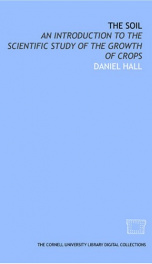fertilisers and manures

Purchase of this book includes free trial access to www.million-books.com where you can read more than a million books for free. This is an OCR edition with typos. Excerpt from book: CHAPTER IV PHOSPHATIC MANURES TheJPhosphates of CalciumThe Early Use of Bones as Manure Preparation of Bone Meal and Steamed Bone FlourDissolved Bones and Bone CompoundsThe Discovery of Mineral Phosphates, Coprolites, Phosphorite, Phosphatic Guanos, Rock PhosphatesThe Invention of Superphosphate, Lawes and LiebigThe Manufacture of Superphosphate The Manufacture of Basic SlagNature of the Phosphoric Acid Compounds in Basic Slag: their Solubility in Dilute Acid SolutionsBasic SuperphosphateWiborg Phosphate Wolter Phosphate. Although the fertilising effect of bones, in common with most other substances of animal origin, had been known in an empirical way for a very long time, the efficacy was generally put down to the oil they contained, and it was only at the close of the eighteenth century that attention became fixed on the phosphoric acid. Lord Dundonald, in his Treatise on the Connection of Agriculture with Chemistry', published in 1795, had arrived at a very sound perception of the case. When treating of phosphate of lime, he writes that it "is contained in animal matters, such as bone, urine, shells, etc., in some sorts of limestone, and in vegetable substances, particularly in the gluten, or the vegeto.animal part of wheat and other grain. It is a saline compound, very insoluble. There is reason to believe a very considerable proportion of this nearly insoluble salt is contained in most fertile soils. . . . These alkaline phosphates (potash and soda) will be found to promote vegetation in a very great degree, the substance of which they are composed, viz., alkaline salts and phosphoric acid, are found in the ashes of most vegetables." Again, Kirwan writes in 1796 about the constituents of plants: " Phosphorated calx is found in greatest quantity in wh...
Info about the book
Author:
Series:
Unknown
ISBN:
1246215659
Rating:
3.5/5 (3)Your rating:
0/5
Languge:
English
Users who have this book
Users who want this book
What readers are saying
What do you think? Write your own comment on this book!
write a commentif you like fertilisers and manures try:
Do you want to read a book that interests you? It’s EASY!
Create an account and send a request for reading to other users on the Webpage of the book!








